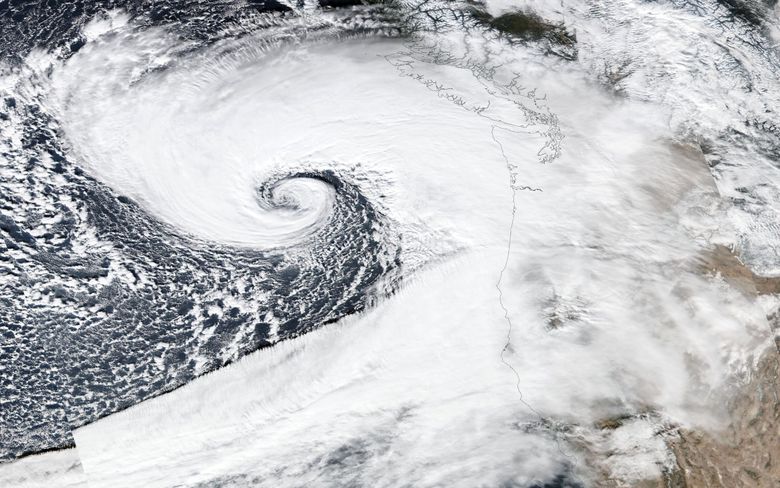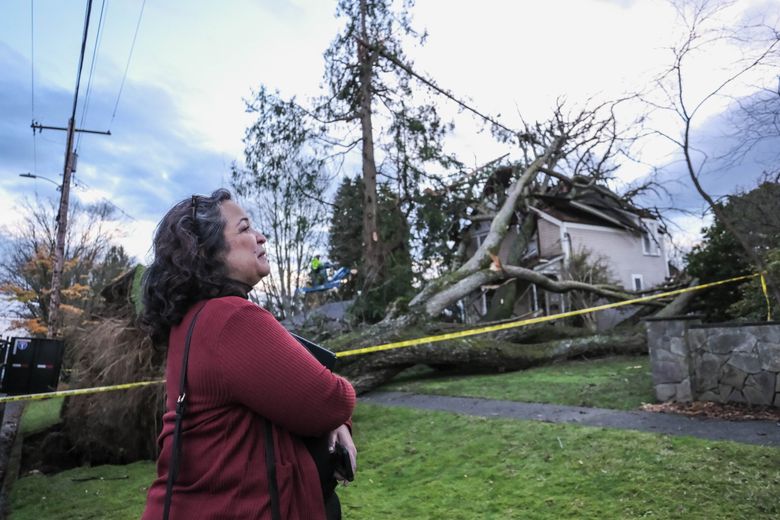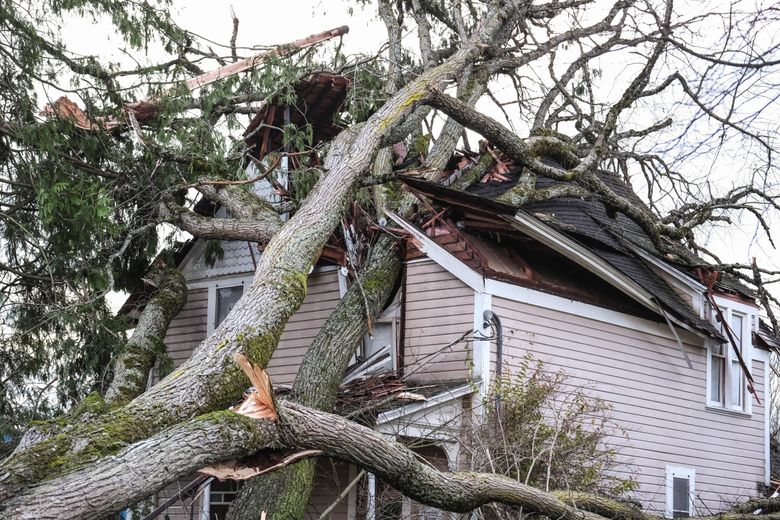Climate Lab
Environment
Local News
Weather
How a powerful bomb cyclone ravaged the Northwest
Nov. 20, 2024 at 4:09 pm Updated Nov. 20, 2024 at 6:01 pm

The aftermath of a bomb cyclone on 35th Avenue Northeast in Seattle. (Karen Ducey / The Seattle Times)
By
Conrad Swanson
and
Catalina Gaitán
Seattle Times staff reporters
This storm was off the charts.
The bomb cyclone emerged from the middle of the Pacific Ocean and swirled with such intensity off Washington’s coast that it ravaged the region Tuesday night, ripping down trees, toppling power lines and killing at least two.
Each storm like this is unique — with its own personality, said Lynn McMurdie, a professor of atmospheric sciences at the University of Washington.
“And this one has a lot of personality,” she said.
Washington weather: Bomb cyclone
Pressure dropped 27 millibars in six hours, about four times faster than the rate meteorologists use to label storms as bomb cyclones. It dropped so far and so fast that, under one method of analysis, it landed in a category reserved for the strongest of its kind: A “ super explosive cyclone.”
Bomb cyclones are common enough, but rarely form as far south as this one did and gather so much strength so quickly, said Jason Ahsenmacher, lead meteorologist for the National Weather Service in Fairbanks, Alaska.
As far back as the records go, a cyclone this strong hasn’t formed before in this part of the world at this time of year, Ahsenmacher said. It belongs to an upper echelon of low-pressure systems.

The bomb cyclone strengthens off Washington’s coast on Tuesday. Pressure dropped 27 millibars in six
hours, about four times faster than the rate meteorologists use to label storms as bomb cyclones and in a fraction of the normal time span. It dropped so far and so fast that, under one method of analysis, it landed in a category reserved for the strongest of its kind: A “super explosive cyclone.” (Courtesy of NASA)
How the bomb cyclone formed
A low-pressure system gathered strength over several days to culminate in an intense cyclone Tuesday night.

Source: University of Washington, Department of Atmospheric Science (Mark Nowlin / The Seattle Times)
As the storm began to grow south of the Aleutian Islands, pressure dropped 27 millibars in six hours, about four times faster than the rate meteorologists use to label the storms as bomb cyclones. The system loosely tracked the Pacific jet stream toward the coast, building strength along the way.
After it began to form, the cyclone loosely tracked the Pacific jet stream. Counterclockwise it churned, heading toward the coast, building strength along the way.
Air over Western Washington rushed toward that low-pressure trough, generating wind gusts of up to 74 mph in places. Hundreds of thousands of people lost power, marking Seattle’s most severe outage since 2006, while two died in the maelstrom. A woman was killed by a falling tree at a Lynnwood homeless encampment. In Bellevue, a 65-year-old another woman was killed by a tree that smashed into her home while she showered. The surrounding neighborhood was struck hard.
Robert Keeney surveyed the devastation to his family’s 6-acre property off 173rd Avenue Northeast on Wednesday. Toppled fir and cedar trees blanketed the landscape. Miraculously, none of the trees hit the house.
Not much else was spared.

| People walk their dog as cars maneuver around downed power lines and trees caused by a bomb cyclone storm on Wednesday in Bellevue. Utility and road crews across the region scrambled to clear the wreckage through Wednesday, and outages could stretch on for days. (Nick Wagner / The Seattle Times)
Three cars were totaled: two buried under a flattened carport and a third crushed under a tree. The pump for a well that supplies the home with water was destroyed, along with a toolshed built by Keeney’s grandfather. A downed power line lay tangled among broken branches behind the house.
“It just kind of goes on and on — it’s absolutely overwhelming,” said Keeney’s sister-in-law, 74-year-old Kathleen Keeney, as she carefully stepped over broken branches. “It’s hard to even know where to start.”
The Keeney family lost power about 6 p.m. As wind gusts intensified, the trees around the home fell one by one. Each crash “felt like an earthquake” and rattled the house, Robert Keeney said.
“It sounded a bit like hell had come to breakfast,” he said. “I’ve been in a lot of windstorms, but this is the first one that actually scared me.”
His grandmother had a saying: “It looks like the locust flew off with a grain of corn.”
“This time,” Keeney said, “the locust took the whole ear.”


1 of 45 | Snohomish Mayor Linda Redmon sees some of the damage done to homes in the city’s historic district by falling trees in Tuesday’s bomb cyclone. Snohomish County saw some of the worst damage from... (Dean Rutz / The Seattle Times)
A characteristic that made this particular storm so damaging was the direction of the winds, east to west, said Karin Bumbaco, deputy state climatologist. Usually, Washington’s strongest winds come from the south or the southwest.
For trees, that makes a difference.
Think of a house plant, growing so its leaves or vines win the best exposure to sunlight. Similarly, trees can grow so their trunks, limbs and even roots resist strong winds from a particular direction, said Ray Larson, curator for the University of Washington Botanic Gardens.
So heavy gusts blowing from the east, especially such strong winds, hit trees across the region at a weak angle, causing them to crack, fall and splinter, Larson said.
Peak wind gusts
Preliminary data recorded between 6 a.m. Tuesday and 6 a.m. Wednesday during the West Coast’s bomb cyclone showed wind speeds of up to 77 mph in Washington.

Sources: National Centers for Environmental Prediction, Weather Prediction Center, CBC News, Environment Canada (Mark Nowlin / The Seattle Times)
Utility and road crews across the region scrambled to clear the wreckage through Wednesday, and outages could stretch on for days.
As strong as this storm was — and it was a “really, really strong storm” — Washington avoided the worst of it because the system never made landfall, said Kirby Cook, science and operations officer for the National Weather Service in Seattle.
Most Read Local Stories Still, utilities expect electricity restoration efforts to take days, closed schools will look to reopen, cities and towns will continue to clear roads and some residents will be repairing damage to their homes and property.
On Wednesday, the cyclone remained hundreds of miles off the coast where it began to dissipate. But a second storm will soon follow a similar path while the first diminishes, Cook said. They’ll almost orbit each other over the Pacific.
In tropical regions, the warming atmosphere (fueled by climate change) means the air can hold more water, leading to larger and stronger hurricanes. But Bumbaco doesn’t see the fingerprints of climate change in this bomb cyclone. These types of storms are common enough, and this just happened to be a strong one.
“It was more of an unlucky deal of the weather cards,” she said.
The incoming storm appears likely to form into another bomb cyclone, Ahsenmacher said. And while it likely also won’t make landfall, it could blow closer to the coast, which could once more bring strong winds.
Trees or branches weakened by the first storm might not survive the second, Larson said. Especially if more rain falls, softening the ground. People should keep a close eye on any foliage that might be at risk, move their cars inside garages whenever possible and try to avoid any unnecessary risks, he said.
Meteorologists will track the development of the new storm over the coming days.
Conrad Swanson reported from Seattle. Catalina Gaitán reported from Bellevue.
Conrad Swanson: 206-464-3805 or cswanson@seattletimes.com; Conrad covers climate change and its intersection with environmental and political issues.
Catalina Gaitán: 206-464-8276 or cgaitan@seattletimes.com; Catalina Gaitán is a staff reporter for The Seattle Times.
seattletimes.com |











